Occurrence of Alkenylbenzenes in Plants: Flavours and Possibly Toxic Plant Metabolites
Abstract
1. Introduction
1.1. Occurrence of Alkenylbenzenes in Herbs, Spices, and Some Vegetables
1.2. Anise and Star Anise
1.3. Basil
1.4. Bay
1.5. Carrot
1.6. Chervil
1.7. Cinnamon
1.8. Clove
1.9. Dill
1.10. Elemi
1.11. Fennel
1.12. Lemon Balm
1.13. Lemon Grass
1.14. Lovage
1.15. Nutmeg
1.16. Parsley
1.17. Pepper
1.18. Purple Haze
1.19. Tarragon
1.20. Ylang-Ylang
2. Discussion
3. Conclusions
Author Contributions
Funding
Institutional Review Board Statement
Informed Consent Statement
Conflicts of Interest
References
- Burdock, G.A. Fenaroli’s Handbook of Flavor Ingredients, 6th ed.; CRC Press: Boca Raton, FL, USA, 2009. [Google Scholar]
- Eisenreich, A.; Götz, M.E.; Sachse, B.; Monien, B.H.; Herrmann, K.; Schäfer, B. Alkenylbenzenes in foods: Aspects impeding the evaluation of adverse health effects. Foods 2021, 10, 2139. [Google Scholar] [CrossRef] [PubMed]
- Götz, M.E.; Sachse, B.; Schäfer, B.; Eisenreich, A. Myristicin and Elemicin: Potentially Toxic Alkenylbenzenes in Food. Foods 2022, 11, 1988. [Google Scholar] [CrossRef] [PubMed]
- Cartus, A.T.; Stegmüller, S.; Simson, N.; Wahl, A.; Neef, S.; Kelm, H.; Schrenk, D. Hepatic Metabolism of Carcinogenic β-Asarone. Chem. Res. Toxicol. 2015, 28, 1760–1773. [Google Scholar] [CrossRef] [PubMed]
- Berg, K.; Bischoff, R.; Stegmüller, S.; Cartus, A.; Schrenk, D. Comparative investigation of the mutagenicity of propenylic and allylic asarone isomers in the Ames fluctuation assay. Mutagenesis 2016, 31, 443–451. [Google Scholar] [CrossRef]
- Cartus, A.T.; Schrenk, D. Metabolism of carcinogenic alpha-asarone by human cytochrome P450 enzymes. Naunyn Schmiedeberg’s Arch. Pharmacol. 2020, 393, 213–223. [Google Scholar] [CrossRef]
- Götz, M.E.; Eisenreich, A.; Sachse, B.; Herrmann, K.; Schäfer, B. P08-04 Mutagenicity testing of alkenylbenzenes: Need for refined approaches due to sulfotransferase-mediated bioactivation. Toxicol. Lett. 2022, 368, S142. [Google Scholar] [CrossRef]
- Atkinson, R.G. Phenylpropenes: Occurrence, Distribution, and Biosynthesis in Fruit. J. Agric. Food Chem. 2018, 66, 2259–2272. [Google Scholar] [CrossRef]
- Prinsloo, G.; Nogemane, N. The effects of season and water availability on chemical composition, secondary metabolites and biological activity in plants. Phytochem. Rev. 2018, 17, 889–902. [Google Scholar] [CrossRef]
- Prinsloo, G.; Nogemane, N.; Street, R. The use of plants containing genotoxic carcinogens as foods and medicine. Food Chem. Toxicol. 2018, 116, 27–39. [Google Scholar] [CrossRef]
- Leung, A.Y.; Foster, S. Encyclopedia of Common Natural Ingredients: Used in Food, Drugs, and Cosmetics, 2nd ed.; John Wiley & Sons: Hoboken, NJ, USA, 2003. [Google Scholar]
- Martinez-Velazquez, M.; Castillo-Herrera, G.A.; Rosario-Cruz, R.; Flores-Fernandez, J.M.; Lopez-Ramirez, J.; Hernandez-Gutierrez, R.; Del Carmen Lugo-Cervantes, E. Acaricidal effect and chemical composition of essential oils extracted from Cuminum cyminum, Pimenta dioica and Ocimum basilicum against the cattle tick Rhipicephalus (Boophilus) microplus (Acari: Ixodidae). Parasitol. Res. 2011, 108, 481–487. [Google Scholar] [CrossRef]
- Padmakumari, K.P.; Sasidharan, I.; Sreekumar, M.M. Composition and antioxidant activity of essential oil of pimento (Pimenta dioica (L) Merr.) from Jamaica. Nat. Prod. Res. 2011, 25, 152–160. [Google Scholar] [CrossRef]
- Nabney, J.; Robinson, F.V. Constituents of pimento berry oil (Pimenta dioica). Flavour Ind. 1972, 3, 50–51. [Google Scholar]
- Veek, M.E.; Russel, G.F. Chemical and sensory properties of pimento leaf oil. J. Food Sci. 1973, 38, 1028–1031. [Google Scholar] [CrossRef]
- Peyron, L.; Acchiardi, J.; Bignotti, D.; Pellerin, P. Baies de pimenta dioïca L., comparaison des extraits provenant de technologies diverses. In Proceedings of the Perfumes and Flavours Symphony of Nature, Technical Data No. 128 VIIIth International Congress of Essential Oils 1980 in Cannes-Grasse, Fedarom, Cannes-Grasse, France, 12–17 October 1980; pp. 433–441. [Google Scholar]
- Green, C.L.; Espinosa, F. Jamaican and Central American Pimento (Allspice; Pimenta dioica): Characterization of flavour differences and other distinguishing features. Dev. Food Sci. 1988, 18, 3–20. [Google Scholar]
- Orav, A.; Raal, A.; Arak, E. Essential oil composition of Pimpinella anisum L. fruits from various European countries. Nat. Prod. Res. 2008, 22, 227–232. [Google Scholar] [CrossRef]
- Embong, M.B.; Hadziyev, D.; Molnar, S. Essential oils from spices grown in Alberta. Anise oil (Pimpinella anisum). Can. J. Plant Sci. 1977, 57, 681–688. [Google Scholar] [CrossRef]
- Anastasopoulou, E.; Graikou, K.; Ganos, C.; Calapai, G.; Chinou, I. Pimpinella anisum seeds essential oil from Lesvos island: Effect of hydrodistillation time, comparison of its aromatic profile with other samples of the Greek market. Safe use. Food Chem. Toxicol. 2020, 135, 110875. [Google Scholar] [CrossRef]
- Rodrigues, V.M.; Rosa, P.T.; Marques, M.O.; Petenate, A.J.; Meireles, M.A. Supercritical extraction of essential oil from aniseed (Pimpinella anisum L) using CO2: Solubility, kinetics, and composition data. J. Agric. Food Chem. 2003, 51, 1518–1523. [Google Scholar] [CrossRef]
- Kubeczka, K.-H.; Bohn, I.; Formaček, V. New constituents from the essential oils of pimpinella species. In Progress in Essential Oil Research; Brunke, E.-J., Ed.; De Gruyter: Berlin, Germany; Boston, MA, USA, 1986; pp. 279–298. [Google Scholar]
- Bricout, J. Sur la constitution de l’huile essentielle de badiane. Bull. Société Chim. Fr. 1974, 384, 1901–1903. [Google Scholar]
- Huang, Y.; Zhao, J.; Zhou, L.; Wang, J.; Gong, Y.; Chen, X.; Guo, Z.; Wang, Q.; Jiang, W. Antifungal activity of the essential oil of Illicium verum fruit and its main component trans-anethole. Molecules 2010, 15, 7558–7569. [Google Scholar] [CrossRef]
- Tuan, D.Q.; Ilangantileke, S.G. Liquid CO2 extraction of essential oil from star anise fruits (Illicium verum H.). J. Food Eng. 1997, 31, 47–57. [Google Scholar] [CrossRef]
- Cu, J.-Q.; Perineau, F.; Goepfert, G. GC/MS Analysis of Star Anise Oil. J. Essent. Oil Res. 1990, 2, 91–92. [Google Scholar] [CrossRef]
- De Maack, F.; Brunet, D.; Malnati, J.C.; Estienne, J. Study of the minor constituents of anethol obtained from the essence of Chinese anise. Contribution to the search for the origins of anethol by sesquiterpene identification [Illicum verum]. Ann. Des. Falsif.L’expertise Chim. Toxicol. 1982, 75, 357–367. [Google Scholar]
- Johanns, E.S.D.; Van der Kolk, L.E.; Van Gemert, H.M.A.; Sijben, A.E.J.; Peters, P.W.J.; De Vries, I. Een epidemie van epileptische aanvallen na drinken van kruidenthee. Ned. Tijdschr. Voor Geneeskd. 2002, 146, 813–816. [Google Scholar]
- Cook, W.B.; Howard, A.S. The essential oil of Illicium anisatum Linn. Can. J. Chem. 1966, 44, 2461–2464. [Google Scholar] [CrossRef]
- Gurav, T.P.; Dholakia, B.B.; Giri, A.P. A glance at the chemodiversity of Ocimum species: Trends, implications, and strategies for the quality and yield improvement of essential oil. Phytochem. Rev. 2022, 21, 879–913. [Google Scholar] [CrossRef]
- Lawrence, B.M. Further examination of the variation of Ocimum basilicum L. In Flavours and Fragrances: A Word Perspective. Proceedings of the 10th International Congress of Essential Oils, Fragrances and Flavors, Washington, DC, USA, 16–20 November 1986; Lawrence, B.M., Mookherjee, B.D., Willis, B.J., Eds.; Elsevier Science Publishers B.V: Amsterdam, The Netherlands, 1988; pp. 161–170. [Google Scholar]
- Zola, A.; Garnero, J. Contribution a L’etude de quelques essences de Basilic de type Europeen. Parfums Cosm. Sav. France 1973, 3, 15–19. [Google Scholar]
- Simon, J.E.; Reiss-Bubenheim, D.; Joly, R.J.; Charles, D.J. Water Stress-Induced Alterations in Essential Oil Content and Composition of Sweet Basil. J. Essent. Oil Res. 1992, 4, 71–75. [Google Scholar] [CrossRef]
- Muráriková, A.; Ťažký, A.; Neugebauerová, J.; Planková, A.; Jampílek, J.; Mučaji, P.; Mikuš, P. Characterization of essential oil composition in different basil species and pot cultures by a GC-MS method. Molecules 2017, 22, 1221. [Google Scholar] [CrossRef]
- Fischer, R.; Nitzan, N.; Chaimovitsh, D.; Rubin, B.; Dudai, N. Variation in essential oil composition within individual leaves of sweet basil (Ocimum basilicum L.) is more affected by leaf position than by leaf age. J. Agr. Food Chem. 2011, 59, 4913–4922. [Google Scholar] [CrossRef]
- Chalchat, J.C.; Özcan, M.M. Comparative essential oil composition of flowers, leaves and stems of basil (Ocimum basilicum L.) used as herb. Food Chem. 2008, 110, 501–503. [Google Scholar] [CrossRef]
- Vani, S.R.; Cheng, S.F.; Chuah, C.H. Comparative study of volatile compounds from genus Ocimum. Am. J. Appl. Sci. 2009, 6, 523–528. [Google Scholar] [CrossRef]
- Brophy, J.; Jogia, M.K. Essential oils from two varieties of Fijian Ocimum sanctum (Tulsi). Fiji Agric. J. 1984, 46, 21–26. [Google Scholar]
- Bousova, K.; Mittendorf, K.; Senyuva, H. A solid-phase microextraction GC/MS/MS method for rapid quantitative analysis of food and beverages for the presence of legally restricted biologically active flavorings. J. AOAC Int. 2011, 94, 1189–1199. [Google Scholar] [CrossRef]
- Siano, F.; Ghizzoni, C.; Gionfriddo, F.; Colombo, E.; Servillo, L.; Castaldo, D. Determination of estragole, safrole and eugenol methyl ether in food products. Food Chem. 2003, 81, 469–475. [Google Scholar] [CrossRef]
- Al-Malahmeh, A.J.; Al-ajlouni, A.M.; Wesseling, S.; Vervoort, J.; Rietjens, I.M.C.M. Determination and risk assessment of naturally occurring genotoxic and carcinogenic alkenylbenzenes in basil-containing sauce of pesto. Toxicol. Rep. 2017, 4, 1–8. [Google Scholar] [CrossRef]
- Analytical Methods Committee. Application of gas-liquid chromatography to the analysis of essential oils. Part IV. Determination of eugenol in oil of bay (Pimenta racemosa, Miller). Analyst 1975, 100, 593–600. [Google Scholar] [CrossRef]
- McHale, D.; Laurie, W.A.; Woof, M.A. Composition of West Indian bay oils. Food Chem. 1977, 2, 19–25. [Google Scholar] [CrossRef]
- Buttery, R.G.; Black, D.R.; Guadagni, D.G.; Ling, L.C.; Teranishi, R.; Connolly, G. California Bay Oil. I. Constituents, Odor Properties. J. Agr. Food Chem. 1974, 22, 773–777. [Google Scholar] [CrossRef]
- MacGregor, J.T.; Layton, L.L.; Buttery, R.G. California bay oil. II. Biological effects of constituents. J. Agric. Food Chem. 1974, 22, 777–780. [Google Scholar] [CrossRef]
- Tucker, A.O.; Maciarello, M.J.; Adams, R.P.; Landrum, L.R.; Zanoni, T.A. Volatile leaf oils of Caribbean Myrtaceae. I. Three varieties of Pimenta racemosa (Miller) J. Moore of the Dominican Republic and the commercial bay oil. J. Essent. Oil Res. 1991, 3, 323–329. [Google Scholar] [CrossRef]
- Hokwerda, H.; Bos, R.; Tattje, D.H.; Malingre, T.M. Composition of essential oils of Laurus nobilis, L. nobilis var. angustifolia and Laurus azorica. Planta Med. 1982, 44, 116–119. [Google Scholar] [CrossRef] [PubMed]
- Putievsky, E.; Ravid, U.; Snir, N.; Sanderovich, D. The essential oils from cultivated bay laurel. Israel J. Bot. 1984, 33, 47–52. [Google Scholar]
- Fiorini, C.; Fourasté, I.; David, B.; Bessière, J.M. Composition of the flower, leaf and stem essential oils from Laurus nobilis L. Flavour Fragr. J. 1997, 12, 91–93. [Google Scholar] [CrossRef]
- Kilic, A.; Hafizoglu, H.; Kollmannsberger, H.; Nitz, S. Volatile constituents and key odorants in leaves, buds, flowers, and fruits of Laurus nobilis L. J. Agric. Food Chem. 2004, 52, 1601–1606. [Google Scholar] [CrossRef]
- Conforti, F.; Statti, G.; Uzunov, D.; Menichini, F. Comparative chemical composition and antioxidant activities of wild and cultivated Laurus nobilis L. leaves and Foeniculum vulgare subsp. piperitum (Ucria) coutinho seeds. Biol. Pharm. Bull. 2006, 29, 2056–2064. [Google Scholar] [CrossRef]
- Verdian-rizi, M.; Hadjiakhoondi, A. Essential oil composition of Laurus nobilis L. of different growth stages growing in Iran. Z. Für Nat. C 2008, 63, 785–788. [Google Scholar] [CrossRef]
- Marzouki, H.; Khaldi, A.; Marongiu, B.; Piras, A.; Harzallah-Skhiri, F. Chemical polymorphism of essential oils from populations of Laurus nobilis grown on Tunisia, Algeria and France. Nat. Prod. Commun. 2011, 6, 1483–1486. [Google Scholar] [CrossRef]
- Marzouki, H.; Piras, A.; Salah, K.B.; Medini, H.; Pivetta, T.; Bouzid, S.; Marongiu, B.; Falconieri, D. Essential oil composition and variability of Laurus nobilis L. growing in Tunisia, comparison and chemometric investigation of different plant organs. Nat. Prod. Res. 2009, 23, 343–354. [Google Scholar] [CrossRef]
- Smaili, T.; Zellagui, A.; Cioni, P.L.; Flamini, G. A myristicin-rich essential oil from Daucus sahariensis growing in Algeria. Nat. Prod. Commun. 2011, 6, 883–886. [Google Scholar] [CrossRef]
- Jabrane, A.; Jannet, H.B.; Harzallah-Skhiri, F.; Mastouri, M.; Casanova, J.; Mighri, Z. Flower and root oils of the Tunisian Daucus carota L. ssp. maritimus (Apiaceae): Integrated analyses by GC, GC/MS, and 13C-NMR spectroscopy, and in vitro antibacterial activity. Chem. Biodivers. 2009, 6, 881–889. [Google Scholar] [CrossRef]
- Mansour, E.S.S.; Maatooq, G.T.; Khalil, A.T.; Marwan, E.S.M.; Sallam, A.A. Essential oil of Daucus glaber Forssk. Z. Naturforsch. Sect. C J. Biosci. 2004, 59, 373–378. [Google Scholar] [CrossRef]
- Marzouki, H.; Khaldi, A.; Falconieri, D.; Piras, A.; Marongiu, B.; Molicotti, P.; Zanetti, S. Essential oils of Daucus carota subsp. carota of Tunisia obtained by supercritical carbon dioxide extraction. Nat. Prod. Commun. 2010, 5, 1955–1958. [Google Scholar] [CrossRef]
- Harborne, J.B.; Heywood, V.H.; Williams, C.A. Distribution of myristicin in seeds of the Umbelliferae. Phytochemistry 1969, 8, 1729–1732. [Google Scholar] [CrossRef]
- Buttery, R.G.; Seifert, R.M.; Guadagni, D.G.; Black, D.R.; Ling, L.C. Characterization of Some Volatile Constituents of Carrots. J. Agr. Food Chem. 1968, 16, 1009–1015. [Google Scholar] [CrossRef]
- Wulf, L.W.; Nagel, C.W.; Branen, A.L. Analysis of Myristicin and Falcarinol in Carrots by High-Pressure Liquid Chromatography. J. Agr. Food Chem. 1978, 26, 1390–1393. [Google Scholar] [CrossRef]
- Ulrich, D.; Nothnagel, T.; Schulz, H. Influence of cultivar and harvest year on the volatile profiles of leaves and roots of carrots (Daucus carota spp. sativus Hoffm.). J. Agric. Food Chem. 2015, 63, 3348–3356. [Google Scholar] [CrossRef]
- Kramer, M.; Bufler, G.; Ulrich, D.; Leitenberger, M.; Conrad, J.; Carle, R.; Kammerer, D.R. Effect of ethylene and 1-methylcyclopropene on bitter compounds in carrots (Daucus carota L.). Postharvest Biol. Tec. 2012, 73, 28–36. [Google Scholar] [CrossRef]
- Zwaving, J.H.; Smith, D.; Bos, R. The essential oil of chervil, Anthriscus cerefolium (L.) Hoffm. Isolation of 1-allyl-2, 4-dimethoxybenzene. Pharm. Weekbl. 1971, 106, 182–189. [Google Scholar]
- Jayaprakasha, G.K.; Rao, L.J. Chemistry, biogenesis, and biological activities of Cinnamomum zeylanicum. Crit. Rev. Food Sci. Nutr. 2011, 51, 547–562. [Google Scholar] [CrossRef]
- Avula, B.; Smillie, T.J.; Wang, Y.H.; Zweigenbaum, J.; Khan, I.A. Authentication of true cinnamon (Cinnamon verum) utilising direct analysis in real time (DART)-QToF-MS. Food Addit. Contam. Part A Chem. Anal. Control. Expo. Risk Assess 2015, 32, 1–8. [Google Scholar] [CrossRef] [PubMed]
- Angmor, J.E.; Dicks, D.M.; Evans, W.C.; Santra, D.K. Studies on Cinnamomum zeylanicum. Planta Med. 1972, 21, 416–420. [Google Scholar] [CrossRef] [PubMed]
- Wijesekera, R.O.B.; Jayewardene, A.L.; Rajapakse, L.S. Volatile constituents of leaf, stem and root oils of cinnamon (Cinnamomum zeylanicum). J. Sci. Food Agric. 1974, 25, 1211–1220. [Google Scholar] [CrossRef]
- Senanayake, U.M.; Lee, T.H.; Wills, R.B.H. Volatile constituents of cinnamon (Cinnamomum zeylanicum) oils. J. Agr. Food Chem. 1978, 26, 822–824. [Google Scholar] [CrossRef]
- Friedman, M.; Kozukue, N.; Harden, L.A. Cinnamaldehyde content in foods determined by gas chromatography-mass spectrometry. J. Agric. Food Chem. 2000, 48, 5702–5709. [Google Scholar] [CrossRef]
- Wang, J.; Su, B.; Jiang, H.; Cui, N.; Yu, Z.; Yang, Y.; Sun, Y. Traditional uses, phytochemistry and pharmacological activities of the genus Cinnamomum (Lauraceae): A review. Fitoterapia 2020, 146, 104675. [Google Scholar] [CrossRef]
- Zhang, C.; Fan, L.; Fan, S.; Wang, J.; Luo, T.; Tang, Y.; Chen, Z.; Yu, L. Cinnamomum cassia Presl: A Review of Its Traditional Uses, Phytochemistry, Pharmacology and Toxicology. Molecules 2019, 24, 3473. [Google Scholar] [CrossRef]
- Cai, L.; Wu, C.D. Compounds from Syzygium aromaticum possessing growth inhibitory activity against oral pathogens. J. Nat. Prod. 1996, 59, 987–990. [Google Scholar] [CrossRef]
- Deyama, T.; Horiguchi, T. Studies on the components of essential oil of clove (Eugenia caryophyllata Thumberg). Yakugaku Zasshi 1971, 91, 1383–1386. [Google Scholar] [CrossRef]
- Chaieb, K.; Hajlaoui, H.; Zmantar, T.; Kahla-Nakbi, A.B.; Rouabhia, M.; Mahdouani, K.; Bakhrouf, A. The chemical composition and biological activity of clove essential oil, Eugenia caryophyllata (Syzigium aromaticum L. Myrtaceae): A short review. Phytother. Res. 2007, 21, 501–506. [Google Scholar] [CrossRef]
- El-Garawani, I.M.; El-Nabi, S.H.; Dawoud, G.T.; Esmail, S.M.; Abdel Moneim, A.E. Triggering of apoptosis and cell cycle arrest by fennel and clove oils in Caco-2 cells: The role of combination. Toxicol. Mech. Methods 2019, 29, 710–722. [Google Scholar] [CrossRef]
- Salzer, U.J. The analysis of essential oils and extracts (oleoresins) from seasonings--a critical review. CRC Crit. Rev. Food Sci. Nutr. 1977, 9, 345–373. [Google Scholar] [CrossRef]
- Baslas, R.K.; Gupta, R.; Baslas, K.K. Chemical examination of essential oils from plants of genus Anethum (Umbelliferae)--oil of seeds of Anethum graveolens. I. Flavour Ind. 1971, 2, 241–245. [Google Scholar]
- Shah, C.S.; Qadry, J.S.; Chauhan, M.G. Constituents of two varieties of Indian dill. J. Pharm. Pharmacol. 1971, 23, 448–450. [Google Scholar] [CrossRef]
- Bandopadhyay, M.; Pardeshi, N.P.; Seshadri, T.R. Comparative study of Anethum graveolens and Anethum sowa. Cur. Sci. 1972, 41, 50–51. [Google Scholar]
- Lichtenstein, E.P.; Liang, T.T.; Schulz, K.R.; Schnoes, H.K.; Carter, G.T. Insecticidal and synergistic components isolated from dill plants. J. Agr. Food Chem. 1974, 22, 658–664. [Google Scholar] [CrossRef]
- Al-Sheddi, E.S.; Al-Zaid, N.A.; Al-Oqail, M.M.; Al-Massarani, S.M.; El-Gamal, A.A.; Farshori, N.N. Evaluation of cytotoxicity, cell cycle arrest and apoptosis induced by Anethum graveolens L. essential oil in human hepatocellular carcinoma cell line. Saudi Pharm. J. 2019, 27, 1053–1060. [Google Scholar] [CrossRef]
- Honda, G.; Koezuka, Y.; Tabata, M. Isolation of dillapiol from a chemotype of Perilla frutescens as an active principle for prolonging hexobarbital-induced sleep. Chem. Pharm. Bull. 1988, 36, 3153–3155. [Google Scholar] [CrossRef]
- Kazemi, M.; Rostami, H. Chemical composition, antimicrobial and antioxidant activities of the essential oil of Psammogeton canescens. Nat. Prod. Res. 2015, 29, 277–280. [Google Scholar] [CrossRef]
- Lawrence, B.M. Progress in essential oils. Perfum. Flavorist 1990, 15, 63–69. [Google Scholar]
- Opdyke, D.L. Elemi oil. Food Cosmet. Toxicol. 1976, 14, 755. [Google Scholar] [CrossRef]
- De Vincenzi, M.; De Vincenzi, A.; Silano, M. Constituents of aromatic plants: Elemicin. Fitoterapia 2004, 75, 615–618. [Google Scholar] [CrossRef]
- Pernet, R. Phytochimie des Burseracees. Lloydia 1972, 35, 280–287. [Google Scholar]
- Trenkle, K. Recent studies on fennel (Foeniculum vulgare M.) 2. The volatile oil of the fruit, herbs and roots of fruit-bearing plants. Pharmazie 1972, 27, 319–324. [Google Scholar] [PubMed]
- Embong, M.B.; Hadziyev, D.; Molnar, S. Essential oils from spices grown in Alberta. Fennel oil (Foeniculum vulgare var. dulce). Can. J. Plant Sci. 1977, 57, 829–837. [Google Scholar] [CrossRef]
- Piccaglia, R.; Marotti, M. Characterization of several aromatic plants grown in northern Italy. Flavour Fragr. J. 1993, 8, 115–122. [Google Scholar] [CrossRef]
- Simándi, B.; Deák, A.; Rónyai, E.; Yanxiang, G.; Veress, T.; Lemberkovics, É.; Then, M.; Sass-Kiss, Á.; Vámos-Falusi, Z. Supercritical carbon dioxide extraction and fractionation of fennel oil. J. Agr. Food Chem. 1999, 47, 1635–1640. [Google Scholar] [CrossRef]
- Marotti, M.; Piccaglia, R. The Influence of Distillation Conditions on the Essential Oil Composition of Three Varieties of Foeniculum vulgare Mill. J. Essent. Oil Res. 1992, 4, 569–576. [Google Scholar] [CrossRef]
- Miguel, M.G.; Cruz, C.; Faleiro, L.; Simoes, M.T.; Figueiredo, A.C.; Barroso, J.G.; Pedro, L.G. Foeniculum vulgare essential oils: Chemical composition, antioxidant and antimicrobial activities. Nat. Prod. Commun. 2010, 5, 319–328. [Google Scholar] [CrossRef]
- Lawrence, B.M. Progress in Essential Oils: Sweet Fennel Oil and Extract. Available online: https://www.perfumerflavorist.com/fragrance/ingredients/article/21860821/progress-in-essential-oils-sweet-fennel-oil-and-extract (accessed on 7 October 2022).
- Mikre, W.; Rohloff, J.; Hymete, A. Volatile constituents and antioxidant activity of essential oils obtained from important aromatic plants of Ethiopia. J. Essent. Oil Bear. Plants 2007, 10, 465–474. [Google Scholar] [CrossRef]
- Hao, Y.; Kang, J.; Guo, X.; Yang, R.; Chen, Y.; Li, J.; Shi, L. Comparison of Nutritional Compositions and Essential Oil Profiles of Different Parts of a Dill and Two Fennel Cultivars. Foods 2021, 10, 1784. [Google Scholar] [CrossRef]
- Basaglia, G.; Fiori, J.; Leoni, A.; Gotti, R. Determination of Estragole in Fennel Herbal Teas by HS-SPME and GC-MS. Anal. Lett. 2014, 47, 268–279. [Google Scholar] [CrossRef]
- Raffo, A.; Nicoli, S.; Leclercq, C. Quantification of estragole in fennel herbal teas: Implications on the assessment of dietary exposure to estragole. Food Chem. Toxicol. 2011, 49, 370–375. [Google Scholar] [CrossRef]
- Denzer, M.Y.; Kirsch, F.; Buettner, A. Are odorant constituents of herbal tea transferred into human milk? J. Agric. Food Chem. 2015, 63, 104–111. [Google Scholar] [CrossRef]
- Hausner, H.; Bredie, W.L.; Molgaard, C.; Petersen, M.A.; Moller, P. Differential transfer of dietary flavour compounds into human breast milk. Physiol. Behav. 2008, 95, 118–124. [Google Scholar] [CrossRef]
- Sarer, E.; Kokdil, G. Constituents of the Essential Oil from Melissa officinalis. Planta Med. 1991, 57, 89–90. [Google Scholar] [CrossRef]
- Mulkens, A.; Kapetanidis, I. Eugenylglucoside, a new natural phenylpropanoid heteroside from Melissa officinalis. J. Nat. Prod. 1988, 51, 496–498. [Google Scholar] [CrossRef]
- Nykänen, I.; Holm, Y.; Hiltunen, R. Composition of the Essential Oil of Agastache foeniculum. Planta Med. 1989, 55, 314–315. [Google Scholar] [CrossRef]
- Nykänen, I.; Nykänen, L. Flavour composition of lemon balm (Melissa officinalis L.) cultivated in Finland. Leb. Wiss. Technol. 1986, 19, 482–485. [Google Scholar]
- Do, D.N.; Nguyen, D.P.; Phung, V.-D.; Le, X.-T.; Le, T.M.; Do, V.M.; Minh, B.Q.; Luu, X.C. Fractionating of lemongrass (Cymbopogon citratus) essential oil by vacuum fractional distillation. Processes 2021, 9, 593. [Google Scholar] [CrossRef]
- Atal, C.K.; Bradu, B.L. Search for aroma chemicals of industrial value from genus Cymbopogon. Part IV. Chandi and Kolar grasses as source of methyl-eugenol. Indian J. Pharm. 1976, 38, 63–64. [Google Scholar]
- Guenther, E. The Essential Oils, 4th ed.; D. Van Nostrand Company Inc.: New York, NY, USA, 1950; pp. 82–115. [Google Scholar]
- Wijesekera, R.O.B. The chemical composition and analysis of citronella oil. J. Natl. Sci. Found. Sri Lanka 1973, 1, 67–81. [Google Scholar]
- Wany, A.; Jha, S.; Nigam, V.K.; Pandey, D.M. Chemical analysis and therapeutic uses of citronella oil from Cymbopogon winterianus: A short review. Int. J. Adv. Res. 2013, 1, 504–521. [Google Scholar]
- Trang, D.T.; Hoang, T.K.V.; Nguyen, T.T.M.; Van Cuong, P.; Dang, N.H.; Dang, H.D.; Nguyen Quang, T.; Dat, N.T. Essential Oils of Lemongrass (Cymbopogon citratus Stapf) Induces Apoptosis and Cell Cycle Arrest in A549 Lung Cancer Cells. BioMed. Res. Int. 2020, 2020, 5924856. [Google Scholar] [CrossRef] [PubMed]
- Blank, I.; Schieberle, P. Analysis of the seasoning-like flavour substances of a commercial lovage extract (Levisticum officinale Koch.). Flavour Fragr. J. 1993, 8, 191–195. [Google Scholar] [CrossRef]
- Semeniuc, C.A.; Socaciu, M.I.; Socaci, S.A.; Muresan, V.; Fogarasi, M.; Rotar, A.M. Chemometric Comparison and Classification of Some Essential Oils Extracted from Plants Belonging to Apiaceae and Lamiaceae Families Based on Their Chemical Composition and Biological Activities. Molecules 2018, 23, 2261. [Google Scholar] [CrossRef]
- Sprea, R.M.; Fernandes, A.; Calhelha, R.C.; Pereira, C.; Pires, T.C.S.P.; Alves, M.J.; Canan, C.; Barros, L.; Amaral, J.S.; Ferreira, I.C.F.R. Chemical and bioactive characterization of the aromatic plant Levisticum officinale W.D.J. Koch: A comprehensive study. Food Funct. 2020, 11, 1292–1303. [Google Scholar] [CrossRef]
- Du, S.S.; Yang, K.; Wang, C.F.; You, C.X.; Geng, Z.F.; Guo, S.S.; Deng, Z.W.; Liu, Z.L. Chemical constituents and activities of the essential oil from Myristica fragrans against cigarette beetle Lasioderma serricorne. Chem. Biodivers. 2014, 11, 1449–1456. [Google Scholar] [CrossRef]
- Analytical Methods Committee. Application of gas—Liquid chromatography to the analysis of essential oils. Part XIV. Monographs for five essential oils. Analyst 1988, 113, 1125–1136. [Google Scholar] [CrossRef]
- Sanford, K.J.; Heinz, D.E. Effects of storage on the volatile composition of nutmeg. Phytochemistry 1971, 10, 1245–1250. [Google Scholar] [CrossRef]
- Lawrence, B.M. Progress in Essential Oils—Galangal Oil, Celery Leaf and Seed Oils. Perfum. Flavorist 2005, 30, 66–75. [Google Scholar]
- Baldry, J.; Dougan, J.; Matthews, W.S.; Nabney, J.; Pickering, G.R.; Robinson, F.V. Composition and Flavour of Nutmeg oils. Int. Flavours Food Addit. 1976, 7, 28–30. [Google Scholar]
- Reeve, D. Naturals-The Spice Trail: Nutmeg-Origins, cultivation and processing. Perfum. Flavorist 2006, 31, 48–51. [Google Scholar]
- Ashokkumar, K.; Vellaikumar, S.; Muthusamy, M.; Dhanya, M.K.; Aiswarya, S. Compositional variation in the leaf, mace, kernel, and seed essential oil of nutmeg (Myristica fragrans Houtt.) from the Western Ghats, India. Nat. Prod. Res. 2022, 36, 432–435. [Google Scholar] [CrossRef]
- Archer, A.W. Determination of safrole and myristicin in nutmeg and mace by high-performance liquid chromatography. J. Chromatogr. A 1988, 438, 117–121. [Google Scholar] [CrossRef]
- Hallstrom, H.; Thuvander, A. Toxicological evaluation of myristicin. Nat. Toxins 1997, 5, 186–192. [Google Scholar] [CrossRef]
- Lopez, P.; Van Sisseren, M.; De Marco, S.; Jekel, A.; De Nijs, M.; Mol, H.G. A straightforward method to determine flavouring substances in food by GC-MS. Food Chem. 2015, 174, 407–416. [Google Scholar] [CrossRef]
- Al-Malahmeh, A.J.; Alajlouni, A.M.; Ning, J.; Wesseling, S.; Vervoort, J.; Rietjens, I.M.C.M. Determination and risk assessment of naturally occurring genotoxic and carcinogenic alkenylbenzenes in nutmeg-based plant food supplements. J. Appl. Toxicol. 2017, 37, 1254–1264. [Google Scholar] [CrossRef]
- Dawidowicz, A.L.; Dybowski, M.P. Simple and rapid determination of myristicin in human serum. Forensic Toxicol. 2013, 31, 119–123. [Google Scholar] [CrossRef]
- Ávila, M.; Zougagh, M.; Escarpa, A.; Rios, A. Determination of alkenylbenzenes and related flavour compounds in food samples by on-column preconcentration-capillary liquid chromatography. J. Chromatogr. A 2009, 1216, 7179–7185. [Google Scholar] [CrossRef]
- Forrest, T.P.; Forrest, J.E.; Heacock, R.A. The isolation of some diarylpropanoids from nutmeg. Naturwissenschaften 1973, 60, 257–258. [Google Scholar] [CrossRef]
- Forrest, J.E.; Heacock, R.A.; Forrest, T.P. The isolation of dehydrodiisoeugenol from the aril of Myristica fragrans HOUTT. Experientia 1973, 29, 139. [Google Scholar] [CrossRef]
- Forrest, J.E.; Heacock, R.A.; Forrest, T.P. Diarylpropanoids from nutmeg and mace (Myristica fragrans Houtt.). J. Chem. Soc. Perkin Trans. 1 1974, 2, 205–209. [Google Scholar] [CrossRef] [PubMed]
- Harvey, D.J. Examination of the diphenylpropanoids of nutmeg as their trimethylsilyl, triethylsilyl and tri-n-propylsilyl derivatives using combined gas chromatography and mass spectrometry. J. Chromatogr. A 1975, 110, 91–102. [Google Scholar] [CrossRef]
- Abourashed, E.A.; El-Alfy, A.T. Chemical diversity and pharmacological significance of the secondary metabolites of nutmeg (Myristica fragrans Houtt.). Phytochem. Rev. 2016, 15, 1035–1056. [Google Scholar] [CrossRef]
- Chiu, S.; Wang, T.; Belski, M.; Abourashed, E.A. HPLC-guided isolation, purification and characterization of phenylpropanoid and phenolic constituents of nutmeg kernel (Myristica fragrans). Nat. Prod. Commun. 2016, 11, 483–488. [Google Scholar] [CrossRef]
- Ha, M.T.; Vu, N.K.; Tran, T.H.; Kim, J.A.; Woo, M.H.; Min, B.S. Phytochemical and pharmacological properties of Myristica fragrans Houtt.: An updated review. Arch. Pharmacal Res. 2020, 43, 1067–1092. [Google Scholar] [CrossRef]
- Beyer, J.; Ehlers, D.; Maurer, H.H. Abuse of nutmeg (Myristica fragrans Houtt.): Studies on the metabolism and the toxicologic detection of its ingredients elemicin, myristicin, and safrole in rat and human urine using gas chromatography/mass spectrometry. Ther. Drug Monit. 2006, 28, 568–575. [Google Scholar] [CrossRef]
- Neukamm, M.A.; Schwelm, H.M.; Vieser, S.; Schiesel, N.; Auwarter, V. Detection of nutmeg abuse by gas chromatography—Mass spectrometric screening of urine. J. Anal. Toxicol. 2020, 44, 103–108. [Google Scholar] [CrossRef]
- Kasting, R.; Sydow, E.V.; Andersson, J. Volatile constituents in leaves of parsley. Phytochemistry 1972, 11, 2277–2282. [Google Scholar] [CrossRef]
- Franz, C.; Glasl, H. Zur Kenntnis der Ätherischen Öle von Petersilie II. Vergleichende Untersuchung des Frucht-, Blatt- und Wurzelöles einiger Petersiliensorten. Qual. Plant. 1976, 25, 253–262. [Google Scholar] [CrossRef]
- Shatar, S.; Altantsetseg, S. Essential oil composition of some plants cultivated in Mongolian climate. J. Essent. Oil Res. 2000, 12, 745–750. [Google Scholar] [CrossRef]
- Simon, J.E.; Quinn, J. Characterization of essential oil of parsley. J. Agr. Food Chem. 1988, 36, 467–472. [Google Scholar] [CrossRef]
- Macleod, A.J.; Snyder, C.H.; Subramanian, G. Volatile aroma constituents of parsley leaves. Phytochemistry 1985, 24, 2623–2627. [Google Scholar] [CrossRef]
- Masanetz, C.; Grosch, W. Key odorants of parsley leaves (Petroselinum crispum [Mill.] Nym. ssp. crispum) by Odour–activity values. Flavour Fragr. J. 1998, 13, 115–124. [Google Scholar] [CrossRef]
- Sharmeen Jugreet, B.; Kouadio Ibrahime, S.; Zengin, G.; Abdallah, H.H.; Fawzi Mahomoodally, M. GC/MS Profiling, In Vitro and In Silico Pharmacological Screening and Principal Component Analysis of Essential Oils from Three Exotic and Two Endemic Plants from Mauritius. Chem. Biodivers. 2021, 18, e2000921. [Google Scholar] [CrossRef]
- Alajlouni, A.M.; Al-Malahmeh, A.J.; Isnaeni, F.N.; Wesseling, S.; Vervoort, J.; Rietjens, I.M.C.M. Level of Alkenylbenzenes in Parsley and Dill Based Teas and Associated Risk Assessment Using the Margin of Exposure Approach. J. Agr. Food Chem. 2016, 64, 8640–8646. [Google Scholar] [CrossRef]
- Alajlouni, A.M.; Al-Malahmeh, A.J.; Wesseling, S.; Kalli, M.; Vervoort, J.; Rietjens, I.M.C.M. Risk assessment of combined exposure to alkenylbenzenes through consumption of plant food supplements containing parsley and dill. Food Addit. Contam. Part A Chem. Anal. Control Expo. Risk Assess. 2017, 34, 2201–2211. [Google Scholar] [CrossRef]
- Salehi, B.; Zakaria, Z.A.; Gyawali, R.; Ibrahim, S.A.; Rajkovic, J.; Shinwari, Z.K.; Khan, T.; Sharifi-Rad, J.; Ozleyen, A.; Turkdonmez, E.; et al. Piper Species: A Comprehensive Review on Their Phytochemistry, Biological Activities and Applications. Molecules 2019, 24, 1364. [Google Scholar] [CrossRef]
- Dosoky, N.S.; Satyal, P.; Barata, L.M.; Da Silva, J.K.R.; Setzer, W.N. Volatiles of Black Pepper Fruits (Piper nigrum L.). Molecules 2019, 24, 4244. [Google Scholar] [CrossRef]
- Rivera-Pérez, A.; López-Ruiz, R.; Romero-González, R.; Garrido Frenich, A. A new strategy based on gas chromatography–high resolution mass spectrometry (GC–HRMS-Q-Orbitrap) for the determination of alkenylbenzenes in pepper and its varieties. Food Chem. 2020, 321, 126727. [Google Scholar] [CrossRef] [PubMed]
- Russell, G.F.; Jennings, W.G. Constituents of black pepper. Oxygenated compounds. J. Agric. Food Chem. 1969, 17, 1107–1112. [Google Scholar] [CrossRef] [PubMed]
- Richard, H.M.; Jennings, W.G. Volatile composition of black pepper. J. Food Sci. 1971, 36, 584–589. [Google Scholar] [CrossRef]
- U.S. National Toxicology Program. NTP Technical Report on the Toxicity Studies of Myristicin (CASRN 607-91-0) Administered by Gavage to F344/NTac Rats and B6C3F1/N Mice. Natl. Toxicol. Program Tech. Rep. Ser. 2019, 95, 1–65. [Google Scholar]
- Jirovetz, L.; Buchbauer, G.; Ngassoum, M.B.; Geissler, M. Aroma compound analysis of Piper nigrum and Piper guineense essential oils from Cameroon using solid-phase microextraction-gas chromatography, solid-phase microextraction-gas chromatography-mass spectrometry and olfactometry. J. Chromatogr. A 2002, 976, 265–275. [Google Scholar] [CrossRef]
- Ekundayo, O.; Laakso, I.; Hiltunen, R.; Adegbola, R.M.; Oguntimein, B.; Sofowora, A. Essential oil constituents of ashanti pepper (piper guineense) fruits (Berries). J. Agr. Food Chem. 1988, 36, 880–882. [Google Scholar] [CrossRef]
- Da Silva, J.K.; Da Trindade, R.; Alves, N.S.; Figueiredo, P.L.; Maia, J.G.S.; Setzer, W.N. Essential oils from neotropical Piper species and their biological activities. Int. J. Mol. Sci. 2017, 18, 2571. [Google Scholar] [CrossRef]
- Xiang, C.P.; Han, J.X.; Li, X.C.; Li, Y.H.; Zhang, Y.; Chen, L.; Qu, Y.; Hao, C.Y.; Li, H.Z.; Yang, C.R.; et al. Chemical Composition and Acetylcholinesterase Inhibitory Activity of Essential Oils from Piper Species. J. Agric. Food Chem. 2017, 65, 3702–3710. [Google Scholar] [CrossRef]
- Barbosa, Q.P.S.; Da Câmara, C.A.G.; Ramos, C.S.; Nascimento, D.C.O.; Lima-Filho, J.V.; Guimarães, E.F. Chemical composition, circadian rhythm and antibacterial activity of essential oils of piper divaricatum: A new source of safrole. Quim. Nova 2012, 35, 1806–1808. [Google Scholar] [CrossRef]
- Van Genderen, M.H.P.; Leclercq, P.A.; Delgado, H.S.; Kanjilal, P.B.; Singh, R.S. Compositional analysis of the leaf oils of Piper callosum Ruiz & Pav. from Peru and Michelia montana Blume from India. Spectroscopy 1999, 14, 51–59. [Google Scholar] [CrossRef]
- Masuda, T.; Inazumi, A.; Yamada, Y.; Padolina, W.G.; Kikuzaki, H.; Nakatani, N. Antimicrobial phenylpropanoids from Piper sarmentosum. Phytochemistry 1991, 30, 3227–3228. [Google Scholar] [CrossRef]
- Kumamoto, J.; Scora, R.W. Structure of sarisan, an isomer of myristicin, isolated from the leaf oil of Beilschmiedia miersii. J. Agr. Food Chem. 2002, 18, 544–545. [Google Scholar] [CrossRef]
- De Lima Moreira, D.; Kaplan, M.A.C.; Guimarães, E.F. Essential Oil Analysis of Two Piper Species (Piperaceae). Anais Acad. Bras. Cienc. 1998, 70, 751–754. [Google Scholar]
- Bizzo, H.R.; Lopes, D.; Abdala, R.V.; Pimentel, F.A.; De Souza, J.A.; Pereira, M.V.G.; Bergter, L.; Guimarães, E.F. Sarisan from leaves of Piper affinis hispidinervum C. DC (long pepper). Flavour Fragr. J. 2001, 16, 113–115. [Google Scholar] [CrossRef]
- Vila, R.; Tomi, F.; Mundina, M.; Santana, A.I.; Solís, P.N.; López Arce, J.B.; Balderrama Iclina, J.L.; Iglesias, J.; Gupta, M.P.; Casanova, J.; et al. Unusual composition of the essential oils from the leaves of Piper aduncum. Flavour Fragr. J. 2005, 20, 67–69. [Google Scholar] [CrossRef]
- Atal, C.K.; Dhar, K.L.; Singh, J. The chemistry of Indian Piper species. Lloydia 1975, 38, 256–264. [Google Scholar]
- Brophy, J.J.; Goldsack, R.J.; Punruckvong, A.; Forster, P.I.; Fookes, C.J.R. Essential Oils of the GenusCrowea(Rutaceae). J. Essent. Oil Res. 1997, 9, 401–409. [Google Scholar] [CrossRef]
- De Lira, P.N.B.; Da Silva, J.K.R.; Andrade, E.H.A.; Sousa, P.J.C.; Silva, N.N.S.; Maia, J.G.S. Essential oil composition of three Peperomia species from the Amazon, Brazil. Nat. Prod. Commun. 2009, 4, 427–430. [Google Scholar] [CrossRef]
- Bessiere, J.M.; Menut, C.; Lamaty, G.; Joseph, H. Variations in the volatile constituents of peperomia rotundifolia schlecht. & cham. grown on different host-trees in guadeloupe. Flavour Fragr. J. 1994, 9, 131–133. [Google Scholar] [CrossRef]
- De Diaz, A.M.P.; Diaz, P.P.; Cardoso, H. Volatile constituents of Peperomia subespatulata. Planta Med. 1988, 54, 92–93. [Google Scholar] [CrossRef]
- Andrade, E.H.A.; Carreira, L.M.M.; Da Silva, M.H.L.; Da Silva, J.D.; Bastos, C.N.; Sousa, P.J.C.; Guimarães, E.F.; Maia, J.G.S. Variability in essential-oil composition of Piper marginatum sensu lato. Chem. Biodivers. 2008, 5, 197–208. [Google Scholar] [CrossRef] [PubMed]
- Maia, J.G.S.; Zohhbi, M.D.B.; Andrade, E.H.A.; Santos, A.S.; Da Silva, M.H.L.; Luz, A.I.R.; Bastos, C.N. Constituents of the essential oil of Piper aduncum L. growing wild in the Amazon region. Flavour Fragr. J. 1998, 13, 269–272. [Google Scholar] [CrossRef]
- Rivera, P.N.; Mosquera, T.; Baldisserotto, A.; Abad, J.; Aillon, C.; Cabezas, D.; Piedra, J.; Coronel, I.; Manfredini, S. Chemical composition and in-vitro biological activities of the essential oil from leaves of Peperomia inaequalifolia Ruiz & Pav. Am. J. Essent. Oils Nat. Prod. 2015, 2, 29–31. [Google Scholar]
- Verma, R.S.; Padalia, R.C.; Goswami, P.; Chauhan, A. Essential oil composition of Peperomia pellucida (L.) Kunth from India. J. Essent. Oil Res. 2015, 27, 89–95. [Google Scholar] [CrossRef]
- Mesquita, K.d.S.M.; Feitosa, B.d.S.; Cruz, J.N.; Ferreira, O.O.; Franco, C.d.J.P.; Cascaes, M.M.; Oliveira, M.S.d.; Andrade, E.H.d.A. Chemical Composition and Preliminary Toxicity Evaluation of the Essential Oil from Peperomia circinnata Link var. circinnata. (Piperaceae) in Artemia salina Leach. Molecules 2021, 26, 7359. [Google Scholar] [CrossRef]
- Van Asselt, E.D.; Banach, J.L.; Van Der Fels-Klerx, H.J. Prioritization of chemical hazards in spices and herbs for European monitoring programs. Food Control 2018, 83, 7–17. [Google Scholar] [CrossRef]
- Thieme, H. On a method for spectrophotometric determination of methylchavicol in estragon oils. Die Pharm. 1968, 23, 339–340. [Google Scholar]
- Tateo, F.; Santamaria, L.; Bianchi, L.; Bianchi, A. Basil oil and tarragon oil: Composition and genotoxicity evaluation. J. Essent. Oil Res. 1989, 1, 111–118. [Google Scholar] [CrossRef]
- De Vincenzi, M.; Silano, M.; Maialetti, F.; Scazzocchio, B. Constituents of aromatic plants: II. Estragole. Fitoterapia 2000, 71, 725–729. [Google Scholar] [CrossRef]
- Vostrowsky, O.; Michaelis, K.; Ihm, H.; Zintl, R.; Knobloch, K. On the essential oil components from tarragon (Artemisia dracunculus L.). Z. Der Lebensm. Unters. Forsch. 1981, 173, 365–367. [Google Scholar] [CrossRef]
- Lawrence, B.M. Progress in essential oils/Progrès dans le domaine des huiles essentielles. Perfum. Flavorist 1988, 13, 44–50. [Google Scholar]
- Burdock, G.A.; Carabin, I.G. Safety assessment of Ylang-Ylang (Cananga spp.) as a food ingredient. Food Chem. Toxicol. 2008, 46, 433–445. [Google Scholar] [CrossRef]
- Tan, L.T.; Lee, L.H.; Yin, W.F.; Chan, C.K.; Abdul Kadir, H.; Chan, K.G.; Goh, B.H. Traditional Uses, Phytochemistry, and Bioactivities of Cananga odorata (Ylang-Ylang). Evid.-Based Complement. Altern. Med. 2015, 2015, 896314. [Google Scholar] [CrossRef]
- Stashenko, E.; Martinez, J.R.; MacKu, C.; Shibamoto, T. HRGC and GC–MS analysis of essential oil from colombian ylang-ylang (Cananga odorata Hook fil. et Thomson, forma genuina). J. High Resolut. Chromatogr. 1993, 16, 441–444. [Google Scholar] [CrossRef]
- Stashenko, E.E.; Prada, N.Q.; Martínez, J.R. HRGC/FID/NPD and HRGGC/MSD study of Colombian ylang-ylang (Cananga odorata) oils obtained by different extraction techniques. J. High Resolut. Chromatogr. 1996, 19, 353–358. [Google Scholar] [CrossRef]
- Qin, X.W.; Hao, C.Y.; He, S.Z.; Wu, G.; Tan, L.H.; Xu, F.; Hu, R.S. Volatile organic compound emissions from different stages of Cananga odorata flower development. Molecules 2014, 19, 8965–8980. [Google Scholar] [CrossRef]
- Stashenko, E.E.; Torres, W.; Morales, J.R.M. A study of the compositional variation of the essential oil of ylang-ylang (Cananga odorata Hook Fil. et Thomson, formagenuina) during flower development. J. High Resolut. Chromatogr. 1995, 18, 101–104. [Google Scholar] [CrossRef]
- Brokl, M.; Fauconnier, M.L.; Benini, C.; Lognay, G.; Du Jardin, P.; Focant, J.F. Improvement of ylang-ylang essential oil characterization by GCxGC-TOFMS. Molecules 2013, 18, 1783–1797. [Google Scholar] [CrossRef]
- Katague, D.B.; Kirch, E.R. Analysis of the volatile components of ylang-ylang oil by gas chromatography. J. Pharm. Sci. 1963, 52, 252–258. [Google Scholar] [CrossRef]
- Gaydou, E.M.; Randriamiharisoa, R.; Bianchini, J.P. Composition of the essential oil of ylang-ylang (Cananga odorata Hook Fil. et Thomson forma genuina) from Madagascar. J. Agr. Food Chem. 1986, 34, 481–487. [Google Scholar] [CrossRef]
- Surburg, H.; Panten, J. Common Fragrance and Flavor Materials: Preparation, Properties and Uses—5th Completely Revised and Enlarged Edition; Wiley-VCH Verlag GmbH & Co. KGaA: Weinheim, Germany, 2006. [Google Scholar] [CrossRef]
- Dima, C.; Dima, S. Essential oils in foods: Extraction, stabilization, and toxicity. Curr. Opin. Food Sci. 2015, 5, 29–35. [Google Scholar] [CrossRef]
- Fornari, T.; Vicente, G.; Vazquez, E.; Garcia-Risco, M.R.; Reglero, G. Isolation of essential oil from different plants and herbs by supercritical fluid extraction. J. Chromatogr. A 2012, 1250, 34–48. [Google Scholar] [CrossRef] [PubMed]
- Roohinejad, S.; Koubaa, M.; Barba, F.J.; Leong, S.Y.; Khelfa, A.; Greiner, R.; Chemat, F. Extraction Methods of Essential Oils From Herbs and Spices. In Essential Oils in Food Processing; John Wiley & Sons: Chichester, UK, 2017; pp. 21–55. [Google Scholar]
- Botanischer Sondergarten Wandsbek. Petersilie—Giftpflanze des Jahres 2023. Available online: https://www.hamburg.de/wandsbek/gdj-2023-petersilie/ (accessed on 24 February 2023).
- Dawidowicz, A.L.; Dybowski, M.P. Determination of myristicin in commonly spices applying SPE/GC. Food Chem. Toxicol. 2012, 50, 2362–2367. [Google Scholar] [CrossRef] [PubMed]
- Tsai, C.-J.; Li, J.-H.; Feng, C.-H. Dual dispersive liquid–liquid microextraction for determination of phenylpropenes in oils by gas chromatography–mass spectrometry. J. Chromatogr. A 2015, 1410, 60–67. [Google Scholar] [CrossRef]
- Cao, X.; Xie, Q.; Zhang, S.; Xu, H.; Su, J.; Zhang, J.; Deng, C.; Song, G. Fabrication of functionalized magnetic microspheres based on monodispersed polystyrene for quantitation of allyl-benzodioxoles coupled with gas chromatography and mass spectrometry. J. Chromatogr. A 2019, 1607, 460402. [Google Scholar] [CrossRef]
- Dang, H.N.P.; Quirino, J.P. Analytical separation of carcinogenic and genotoxic alkenylbenzenes in foods and related products (2010–2020). Toxins 2021, 13, 387. [Google Scholar] [CrossRef]
- Dang, H.N.P.; Quirino, J.P. High performance liquid chromatography versus stacking-micellar electrokinetic chromatography for the determination of potentially toxic alkenylbenzenes in food flavouring ingredients. Molecules 2022, 27, 13. [Google Scholar] [CrossRef]
- Deutsches Institut für Normung. Untersuchung von Lebensmitteln—Bestimmung von Estragol im Teeaufguss mittels GC/MS: Untersuchungsparameter: Estragol, Isosafrol, Methyleugenol, Safrol, alpha-Thujon, ß-Asaron; Verfahrensprinzipien: GC/MS. Technol. Regel 2004, BVL L 47.08-2. [Google Scholar]
- Deutsches Institut für Normung. Untersuchung von Lebensmitteln—Bestimmung von Estragol in Aufgüssen aus Fenchel und anderen teeähnlichen Erzeugnissen—GC-MS-Verfahren, Ausgabe 2006-09. Technol. Regel 2006, BVL L 47.08-3. [Google Scholar]
trans-Anethole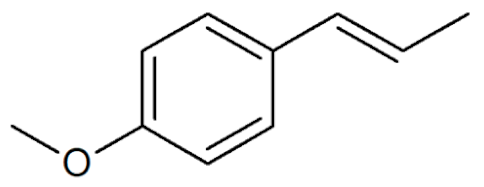 | Anise, seeds (Pimpinella anisum); Cicely, leaf oils (Sweet chervil; Myrrhis odorata); Fennel (Foeniculum vulgare); Tarragon (Artemisia dracunculus) |
Apiol from Dill | Dill (e.g., Anethum graveolens and Anethum sowa); Pepper, some variants (Piper spp.) |
trans-Iso-Dill–Apiol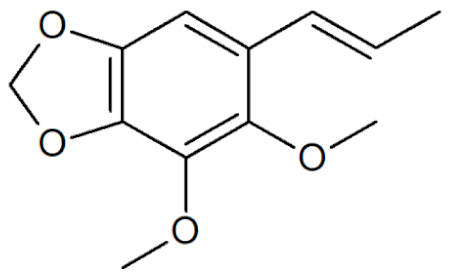 | Dill (Anethum graveolens and Anethum sowa); Sea Fennel or Rock Samphire (Crithmum maritimum) |
Apiol from Parsley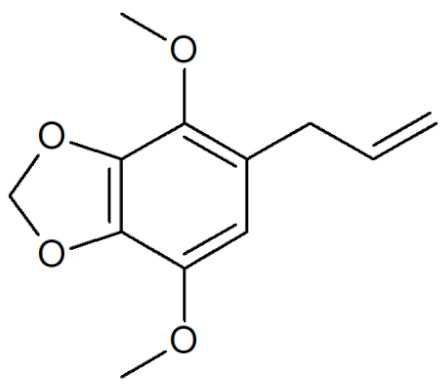 | Parsley (Petroselinum spp.) |
| trans-alpha-Asarone (prohibited in the U.S.A.) 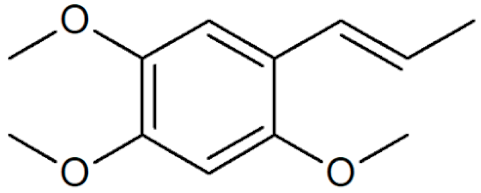 | Flag, sweet (Acorus calamus) |
| cis-beta-Asarone (prohibited in the U.S.A.) (restricted §)  | Flag, sweet (Acorus calamus) |
| gamma-Asarone (prohibited in the U.S.A.) 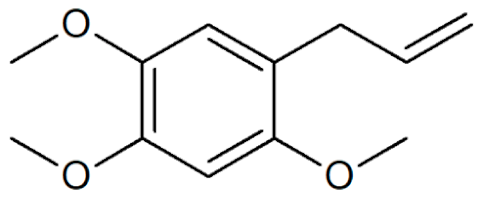 | Flag, sweet, (Acorus calamus) |
Carpacin | Carpano Tree, stem bark (Cinnamomum spp.); Waxflower, leaves (Crowea exalata) |
Chavicol (4-Allylphenol)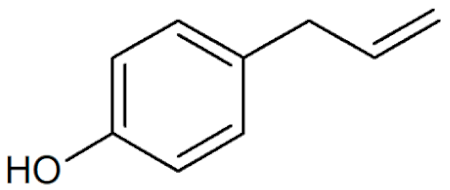 | Betel, leaves (Piper betle); Bay, leaves (Pimenta racemosa) |
Croweacin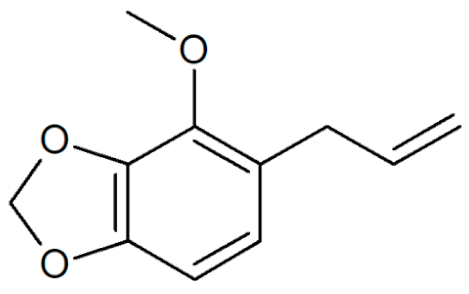 | Waxflower, leaves (Crowea exalata); Wild ginger, leaves (Asarum hypogynum and A. costatum); Willow-leaved crowea, leaves (Crowea saligna) |
Iso-Croweacin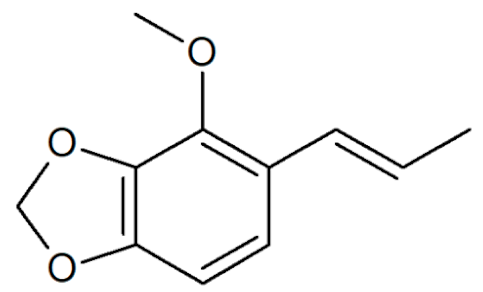 | Waxflower, leaves (Crowea exalata) |
Elemicin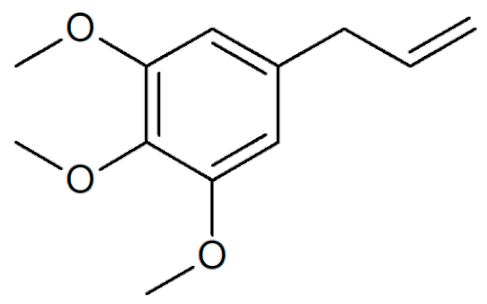 | Carrot, wild, seeds (Daucus carota spp.); Elemi, oils (Canarium commune and C. luzonicum and C. spp.); Nutmeg, kernel and mace (Myristica fragrans); Parsley seeds (Petroselinum spp.) |
trans-Iso-Elemicin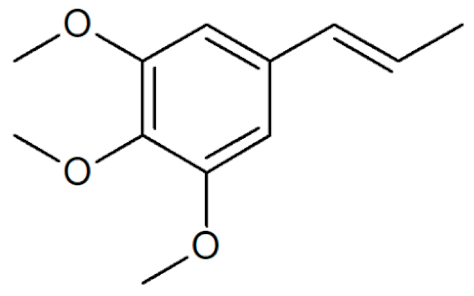 | Nutmeg, kernel and mace (Myristica fragrans) |
6-Methoxy-Elemicin  | Parsley (Petroselinum spp.) |
| Estragole (Methylchavicol) (restricted §)  | Anise, seeds (Pimpinella anisum); Basil, all parts (Ocimum basilicum spp.); Chervil (Anthriscus cerefolium); Fennel, seeds (Foeniculum vulgare); Tarragon (Artemisia dracunculus) |
Eugenol | Basil, leaves (Ocimum spp.); Bay sweet, leaves (Laurus nobilis); Cloves (Syzygium aromaticum); Cinnamon, leaves (Cinnamomum spp.); Sweet bay, leaves (Laurus nobilis); Piment, berries and leaves (Pimenta dioica, Pimenta racemosa); Chervil, aerial parts (Anthriscus cerefolium); Cherries, sweet and sour, as well as many other fruits |
meta-Eugenol (Chavibetol) | Pimenta pseudocaryophyllus, leaves (Brasil); Betel, leaves (Piper betle) |
ortho-Eugenol | Dill (Anethum graveolens and Anethum sowa) |
Acetyleugenol  | Basil, some variants (Ocimum basilicum spp.); Bay sweet, leaves (Laurus nobilis); Clove, flower buds and leaves (Syzygium aromaticum) |
trans-Iso-Eugenol | Ylang-ylang, tree flowers (Canangium odoratum genuine) |
trans-pseudo-Iso-Eugenyl-2-methylbutyrate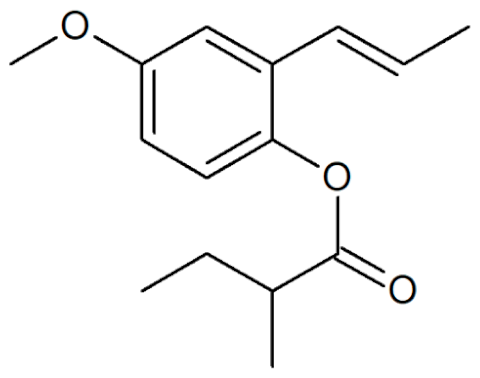 | Anise, seeds (Pimpinella anisum) |
6-Methoxyeugenol 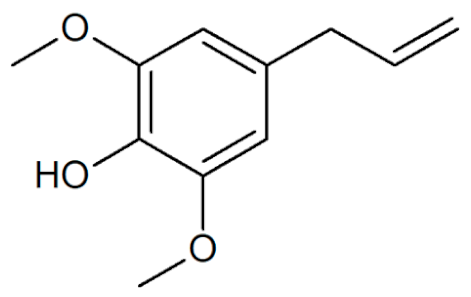 | Nutmeg, kernel and mace (Myristica fragrans) |
Exalatacin  | Waxflower, leaves (Crowea exalata) |
| Methyleugenol (restricted §) 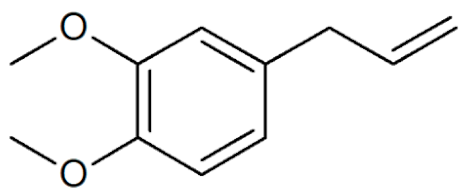 | Basil, all parts (Ocimum spp.); Bay sweet, leaves (Laurus nobilis); Carrot seed, oils (Daucus carota spp.); Cinnamon, all parts (Cinnamomum spp.); Citronella, oils (Cymbopogon winterianus); Cloves, flower buds (Syzygium aromaticum); Nutmeg, kernel and mace (Myristica fragrans); Ysop (Hyssopus officinalis) |
trans-Iso-Methyleugenol | Carrot, seeds of some variants (Daucus carota spp.); Citronella, oils (Cymbopogon winterianus) |
Myristicin 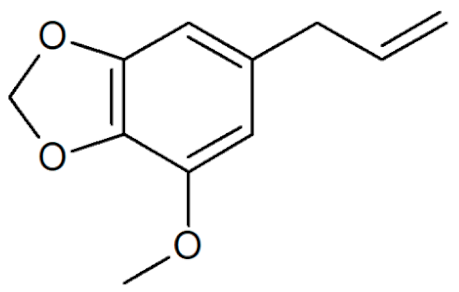 | Anise, seeds (Pimpinella anisum); Carrot, seeds and roots of some variants (Daucus carota); Dill, oils (Anethum graveolens and Anethum sowa); Fennel (Foeniculum vulgare); Nutmeg, kernel and mace (Myristica fragrans); Parsley, leaves and seeds (Petroselinum spp.); Parsnip, roots (Pastinaca sativa) |
trans-Iso-Myristicin | Nutmeg, kernel and mace (Myristica fragrans); Parsley (Petroselinum sativum); Dill (Anethum graveolens and Anethum sowa) |
trans-Nothosmyrnol | Chervil (Anthriscus cerefolium) |
Osmorhizole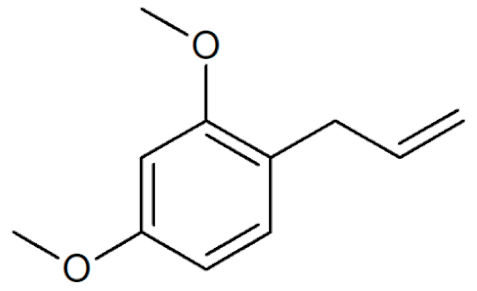 | Chervil (Anthriscus cerefolium) |
| Safrole (prohibited in the U.S.A.) (restricted §)  | Anise, seed (Pimpinella anisum); Camphor tree; wood branches and leaves (Camphora officinarum and Cinnamomum camphora); Cinmamon, leaves (Cinnamomum zeylanicum and C. cassia) Fennelwood tree, roots (Sassafras albidum); Nutmeg, leaves, kernel and mace (Myristica fragrans); Sweetwood, stem bark (Ocotea opifera); Piper auritum, leaves; Piper divaricatum, all parts; Piper hispidinervum, leaves |
| trans-Iso-Safrole (prohibited in the U.S.A.) 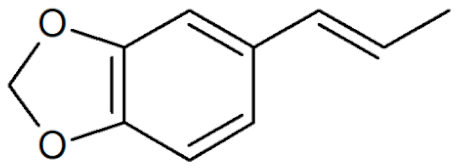 | Nutmeg, kernel and mace (Myristica fragrans); Pepper, several parts and variants (Piper spp.); Ylang-ylang, tree flower (Canangium odoratum genuine) |
Sarisan | Alpine Lovage, roots (Ligusticum mutellina); Ginger, wild, roots (Asarum heterotropoides); Sweetwood, stem bark (Ocotea opifera); Pepper, several (Piper spp., e.g., EOs from ripe berries of Piper guineense, from roots of Piper auritum, from leaves of Piper solmsianum, Piper callosum, Piper affinis hispidinervum, and of Beilschmiedia miersii) |
| Common Name | Species | Family | Ab 1 in EO | Ab 2 in EO |
|---|---|---|---|---|
| Allspice | Pimenta dioica | Myrtaceae | Methyleugenol 0.1–82% in EO from berries | Eugenol 8–95% in EO from berries |
| Anise | Pimpinella anisum | Apiaceae | trans-Anethole 80–90% in EO from dried ripe fruits | Estragole 1–8% in EO from dried ripe fruits |
| Chinese Star Anise | Illicium verum | Illiciaceae | trans-Anethole 88–92% in EO from dried ripe fruits | Estragole 0.5–5.5% in EO from dried ripe fruits |
| Japanese Star Anise | Illicium anisatum | Illiciaceae | Methyleugenol 9.8% in EO from dried ripe fruits | Safrole 6.6% in EO from dried ripe fruits |
| Basil, sweet | Ocimum basilicum | Lamiaceae | Methyleugenol 9–87% in EO of all aerial parts | Estragole 0–58% in EO of all aerial parts |
| Bay | Pimenta racemosa | Myrtaceae | Eugenol 0–66% in EO from leaves | Methyleugenol 0–64% in EO from leaves |
| Bay, sweet | Laurus nobilis | Lauraceae | Methyleugenol up to 21% in EO from wild leaves | Elemicin up to 5% in EO from wild leaves |
| Carrot | Daucus carota sativa | Apiaceae | Myristicin in EO from carrot roots (40 ppm) | Myristicin in EO from carrot roots (0.5–15 ppm) |
| Carrot, wild | Daucus carota sahariensis | Apiaceae | Myristicin 44% in EO from carrot roots | Myristicin 34% in EO from carrot leaves |
| Chervil | Anthriscus cerefolium | Apiaceae | Estragole 75–80% in EO from aerial parts | 1-Allyl-2,4-dimethoxybenzene unknown quantity |
| Cinnamon | Cinnamomum ceylanicum, and C. cassia | Lauraceae | Eugenol up to 87% in EO from leaves | Safrole (traces) in EO from bark |
| Clove | Syzygium aromaticum | Myrtaceae | Eugenol up to 89% in EO from air-dried buds | Acetyleugenol up to 7% in EO from air-dried buds |
| Dill | Anethum graveolens | Apiaceae | Dill–Apiol up to 25% in EO from dill seeds and also from roots (up to 67%) | Myristicin 0.2% in EO from seeds and 4.4% in EO from roots |
| Dill | Anethum sowa | Apiaceae | Dill–Apiol 12–15% in EO from dill seeds | Myristicin 0.2% in EO from dill seeds |
| Elemi | Canarium commune | Burseraceae | Elemicin in oleoresins from distillations of resinous exudations from trees | Not yet defined |
| Fennel | Foeniculum vulgare var. dulce | Apiaceae | trans-Anethole 60–90% or up to 88% estragole in EO from seeds and other aerial parts | Dill–apiol up to 94% in EO from fennel roots |
| Lemon Balm | Melissa officinalis | Lamiaceae | Estragole 6,3% in EO from leaves | Eugenol 3.5–4.5% Eugenylglucoside in EO from dried leaves or flowers |
| Cylon Lemon Grass | Cymbopogon nardus | Poaceae | Iso-Methyleugenol 7.2% in EO from leaves | Methyleugenol 1.7% in EO from leaves |
| Lovage | Levisticum officinale | Apiaceae | trans-Anethole 0.3% in EO from aerial parts | Not identified |
| Nutmeg | Myristica fragrans | Myristicaceae | Myristicin 0.5–12.4% in EO from kernels | Elemicin 0.3–4.6% in EO from kernels |
| Parsley | Petroselinum sativum, and P. Crispum | Umbelliferae | Myristicin 20.3–94.1% in EO from seeds | Parsley–apiol 0.6–78.7% in EO from seeds |
| Pepper | Piper nigrum | Piperaceae | Eugenol 10–120 mg/kg in EO from berries | Estragole 2.2–46 mg/kg in EO from berries |
| Pepper | Piper guineense | Piperaceae | Myristicin 17% in EO from berries | Sarisan 16% in EO from berries |
| Purple Haze | Agastache foeniculum | Lamiaceae | Estragol 40–93% in EO from aerial parts | Methyleugenol 0.2–44% in EO from aerial parts |
| Tarragon | Artemisia dracunculus | Asteraceae | Estragole up to 69% in EO from leaves | Methyleugenol up to 28% in EO from seeds |
| Ylang-ylang | Canangium odoratum genuine | Annonaceae | trans-Anethole 0.3–0.6% in EO from flowers | Methyleugenol 0.2–1.5% in EO from flowers |
Disclaimer/Publisher’s Note: The statements, opinions and data contained in all publications are solely those of the individual author(s) and contributor(s) and not of MDPI and/or the editor(s). MDPI and/or the editor(s) disclaim responsibility for any injury to people or property resulting from any ideas, methods, instructions or products referred to in the content. |
© 2023 by the authors. Licensee MDPI, Basel, Switzerland. This article is an open access article distributed under the terms and conditions of the Creative Commons Attribution (CC BY) license (https://creativecommons.org/licenses/by/4.0/).
Share and Cite
Götz, M.E.; Eisenreich, A.; Frenzel, J.; Sachse, B.; Schäfer, B. Occurrence of Alkenylbenzenes in Plants: Flavours and Possibly Toxic Plant Metabolites. Plants 2023, 12, 2075. https://doi.org/10.3390/plants12112075
Götz ME, Eisenreich A, Frenzel J, Sachse B, Schäfer B. Occurrence of Alkenylbenzenes in Plants: Flavours and Possibly Toxic Plant Metabolites. Plants. 2023; 12(11):2075. https://doi.org/10.3390/plants12112075
Chicago/Turabian StyleGötz, Mario E., Andreas Eisenreich, Janine Frenzel, Benjamin Sachse, and Bernd Schäfer. 2023. "Occurrence of Alkenylbenzenes in Plants: Flavours and Possibly Toxic Plant Metabolites" Plants 12, no. 11: 2075. https://doi.org/10.3390/plants12112075
APA StyleGötz, M. E., Eisenreich, A., Frenzel, J., Sachse, B., & Schäfer, B. (2023). Occurrence of Alkenylbenzenes in Plants: Flavours and Possibly Toxic Plant Metabolites. Plants, 12(11), 2075. https://doi.org/10.3390/plants12112075





